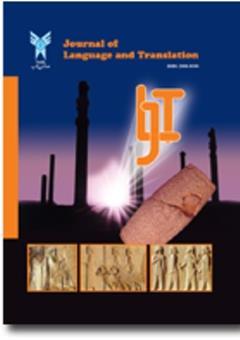Collocations and Colligations in the Scientific Research Articles in Terms of Lexical Priming Theory: Analysis of Hard and Soft Sciences
Subject Areas : All areas of language and translationLeila Ghaemi 1 , Nesa Nabifar 2 , Davud Kuhi 3
1 -
2 -
3 -
Keywords: Colligations, Collocations, Introduction Sections, Hard and Soft Disciplines,
Abstract :
Lexical Priming Theory claims that the collocational primings of a word depend on the genre or discipline in which it occurs. In this study, attempts were made to compare the collocates and colligates and the positions of the collocates prior and subsequent to the node word in two specialized corpora of soft science and hard science to see if they are realized in the same or different ways. To serve this purpose, the introduction section of 1000 RAs of two disciplines of soft and hard were gathered from disciplines of applied linguistics, sociology, and psychology (soft science) and computer science, chemistry, physics and medical science (hard science) in order to find a relationship between these two types of RAs with differences in discipline and the authors’ use of collocations and colligations. The findings revealed that the frequency of collocations that employed in the introduction sections of soft and hard sciences were not the same and the researchers of soft science in designing their research articles’ introduction sections employed more collocations in comparison to the researchers in hard science. Hence, based on the results of Chi-square data analysis, it can be claimed that there is a significant difference between two groups of authors in using colocations. However, in terms of colligations, both groups used colligations with the same rates and similarities in the right and the left positions of the collocations, hence it can be claimed that there is no difference in two sciences in terms of high dominant colligations.
Almela-Sánchez, M., & Cantos-Gómez, P. (2019). The Grammatical Environment of Intensifier-Noun Collocations: Insights from Lexical Priming Theory. InInternational Conference on Computational and Corpus-Based Phraseology (pp. 1-14). Springer, Cham.
Anthony, L. (2011). Antconc (Version 3.2. 4w) [Computer Software]. Tokyo: Waseda University, [cit. 31.5. 2015]. Dostupné na: http://www. antlab. sci. waseda. ac. jp/antconc_index. html.
Barlow, M. (2016). Wordskew: Linking corpus data and discourse structure. International Journal of Corpus Linguistics, 21(1), 105–115.
Dahunsi, T. N., & Ewata, T. O. (2022). An exploration of the structural and colligational characteristics of lexical bundles in L1–L2 corpora for English language teaching. Language Teaching Research, 13621688211066572.
Gu, B. J. (2017). Corpus-based study of two synonyms: Obtain and gain. Sino-US English Teaching, 8, 511-522.
Halliday, M. A. K. (1966). Lexis as a linguistic level’ in C. Bazell, J. Catford, M. A. K. Halliday, and R. Robins (eds): In Memory of J.R. Firth. London: Longman, pp. 148–62.
Hoey, M. (1991). Patterns of Lexis in Text. Oxford: Oxford University Press.
Hoey, M. (2003). Why grammar is beyond belief. In J.-P. van Noppen, C. Den Tandt, & I. Tudor (Eds.), Beyond: New perspectives in language, literature and ELT (Belgian journal of English language and literature, new series, 1, pp. 183–96). Ghent, Belgium: Academia Press.
Hoey, M. (2004). The textual priming of lexis. In S. Bernadini, G. Aston, & D. Stewart (Eds.), Corpora and language learners (pp. 21–41). Amsterdam, Netherlands: John Benjamins.
Hoey, M. (2005). Lexical priming: A new theory of words and Language. London: Routledge.
Hoey, M. (2012). Lexical priming: A new theory of words and language. Routledge.
Liardét, C. L. (2013). An exploration of Chinese EFL learner's deployment of grammatical metaphor: Learning to make academically valued meanings. Journal of Second Language Writing, 22(2), 161-178.
Novakova, I., & Siepmann, D. (2020). Literary style, corpus stylistic, and lexico-grammatical narrative patterns: Toward the concept of literary motifs. In Phraseology and Style in Subgenres of the Novel (pp. 1-15). Palgrave Macmillan, Cham.
Pace-Sigge, M. (2018). Spreading activation, lexical priming and the semantic web: early psycholinguistic theories, corpus linguistics and AI applications. Springer.
Patterson, K. J. (2016). The analysis of metaphor: to what extent can the theory of lexical priming help our understanding of metaphor usage and comprehension? Journal of psycholinguistic research, 45(2), 237-258.
Pecorari, D. (2006). Visible and occluded citation features in postgraduate second-language writing. English for specific purposes, 25(1), 4-29.
Römer, U. (2022). Applied corpus linguistics for language acquisition, pedagogy, and beyond. Language Teaching, 55(2), 233-244.
Subtirelu, N. C., & Baker, P. (2017). Corpus-based approaches. In The Routledge handbook of critical discourse studies (pp. 106-119). Routledge.
Thompson, P. (2014). Exploring Hoey's notion of text colligation in a corpus of student writing. In Diachrony and Synchrony in English Corpus Linguistics (pp. 347-371). Peter Lang.


